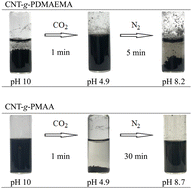Two-way CO2-responsive dispersions of carbon nanotubes in water†
Abstract
The “grafting to” method was used to functionalize carbon nanotubes (CNTs) with poly[2-(dimethylamino)ethyl methacrylate] (PDMAEMA) by applying an atom transfer radical reaction. The obtained CNT-g-PDMAEMA was subjected to consecutive quaternization and alkaline hydrolysis to transform PDMAEMA on the surface of CNTs into poly(methacrylic acid) (PMAA). It was found that both CNT-g-PDMAEMA and CNT-g-PMAA could be easily dispersed in an aqueous media and also exhibited the pH- and CO2-responsive behavior. While CNT-g-PDMAEMA remained stably dispersed in an acidic environment and readily precipitated at high pH values, CNT-g-PMAA displayed a reversed direction of responsiveness, staying dispersed in the basic environment and aggregating when the solution's pH was lowered. Most importantly, we demonstrated that CNTs grafted with PDMAEMA could undergo CO2-triggered redispersion, and on the other hand, CNTs grafted with PMAA could be easily switched to the agglomerated state by bubbling CO2 in the basic medium. Elimination of CO2 from the solutions by purging with an inert gas reverted the original appearance of CNTs. Thus, a unique two-way gas responsive system of manipulating CNT dispersibility was created through a sequence of simple chemical modifications. Furthermore, because CNTs acquired the ability to respond to the CO2 trigger, the addition of acids and bases to the solutions to cause coagulation was no longer required, and as a result, the accumulation of salts in the system could be prevented; that altogether establishes a green and environmentally friendly way of manipulating CNT dispersions.



 Please wait while we load your content...
Please wait while we load your content...